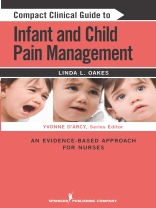Named a 2013 Doody’s Core Title!
‘I would recommend this great little book for nurses who wish to carry a book with them in their clinical practice. Itís a great addition to the growing list of books addressing pain in pediatrics.’–Pediatric Pain Letter
‘[This book] is a practical guide to pediatric pain assessment and management for the advanced practice nurse and primary caregivers who are interested in caring for patients with pain, but whose care specialty is not pain management. For the nurses whose specialty is pain management, this text provides a quick pediatric reference of our knowledge and tools of our trade. Even though it is a ‘compact guide, ‘ this text is well referenced with current key position statements, clinical practice guidelines, and primary references of the latest pediatric pain management research.’– Pain Management Nursing
Presented in a concise, systematic format, this clinically oriented book provides nurses and physicians quick access to up-to-date information on how to assess and manage pain in infants and children, including adolescents who suffer from acute and chronic pain conditions. This book provides a comprehensive review of medications for infants and children as well as nonpharmacological interventions to achieve optimal pain management for young patients undergoing needle-related procedures as well as painful conditions related to surgery, trauma, cancer, sickle cell disease, and chronic pain.
Key Features:- Describes the consequences of untreated pain on development of children
- Summarizes pain assessment tools recommended for verbal and preverbal patients as well as those who are critically or terminally ill
- Provides general principles and specific dosing recommendations for non-opioids, opioids, and coanalgesics for optimal safety and effective reduction in pain
- Describes the indications, medications, and ongoing care and monitoring related to the increasing use of epidural and continuous peripheral nerve block infusions for pediatric patients
- Provides information on how to use age-appropriate strategies for cognitive, cognitive-behavioral, and physical approaches to reduce pain
- Includes useful resources, such as websites, and other tools, such as pain diaries and patient education information, to support multidisciplinary teams and parents who care for children with acute and chronic pain
Зміст
‘
Section I: Overview of pain in infants and children
Section II: Common medications for managing acute and chronic pain
Chapter 3: Non-opioids
Chapter 4: Opioids
Chapter 5: Co-analgesics (adjunct medications); neuropathic pain
Section III: Neuroaxial methods for managing pain
Chapter 6: Epidural
Chapter 7: Peripheral nerve blocks
Section IV: Nonpharmacologic methods of pain management
Chapter 8. Common: relaxation and distraction
Chapter 9: Guided imagery and hypnotherapy
Chatper 10: Physical approaches: heat, cold, exercise, massage, sucrose
Section V: Integration of methods of treatment
Chapter 11: Multi-disciplinary approach
Chapter 12: Role of parents as coaches
Section IV: Special treatment considerations for pain including impact on the family
Chapter 13: Needle-related procedures: local anesthetic administration methods
Chapter 14: Managing Pain in Critically ill infants and children
Chapter 15: Managing Pain in Terminally ill patients including role
Section V: Managing common pain conditions
Chapter 16: Postoperative Pain
Chapter 17: Pain Associated with Trauma including amputation
Chapter 18: Cancer Pain: acute and chronic
Chapter 19: Sickle cell disease Pain
Tables and Appendices
- Pain Assessment Scales
- Dosing Guidelines for Nonopioid analgesics
- Dosing Guidelines for Initiation of Opioids
- Equianalgesic Conversion Table
- Medications to Prevent or Relieve Opioid-induced Constipation
- Management of Needle-related Pain
- Examples of pain diaries/role of the family
- References and Selected Websites
Про автора
Yvonne D’Arcy, MS, CRNP, CNS, is the Pain and Palliative Care Nurse Practitioner at Suburban Hospital- Johns Hopkins Medicine in Bethesda, Maryland.












